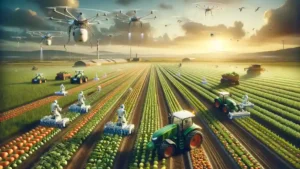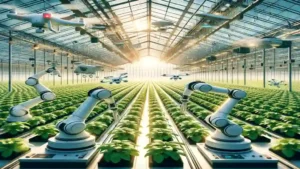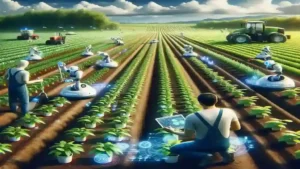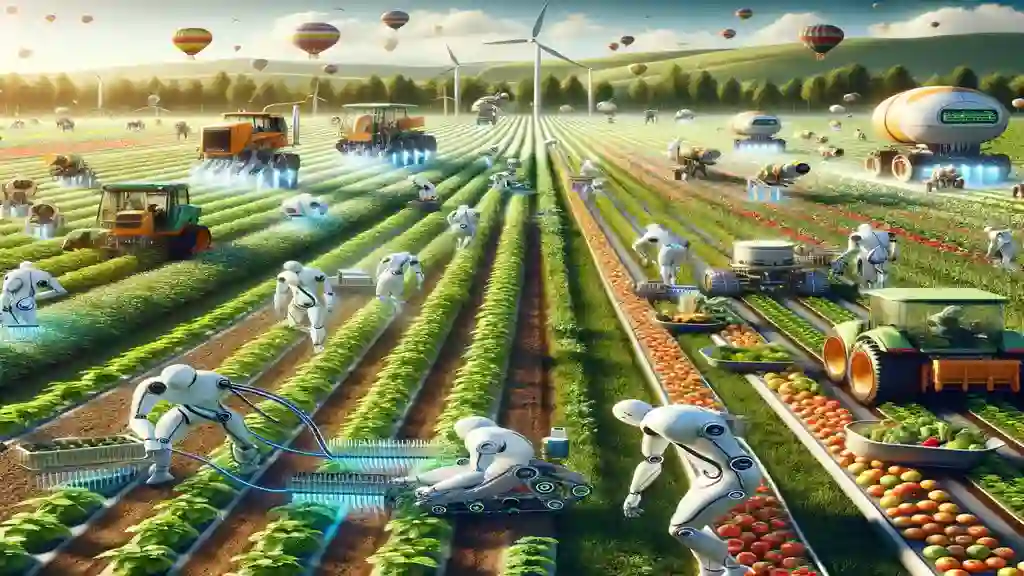Are you ready to witness the future of agriculture unfold right before your eyes? Picture this: fields bustling with robotic helpers, efficiently planting seeds, tending crops, and harvesting produce. Welcome to the era of robotic farming – a revolutionary concept that is not only reshaping traditional agricultural practices but also paving the way for a more sustainable and efficient future. Let’s delve into the world of robotic farming and discover how it is transforming the way we grow our food!
Overview of robotic farming
Welcome to the future of agriculture, where technology meets sustainability in robotic farming. Imagine fields being tended by autonomous machines, working tirelessly day and night to ensure optimal crop growth.
Robotic farming is revolutionizing traditional agricultural practices by integrating cutting-edge robotics into every aspect of farming operations. From planting seeds with precision to monitoring crop health in real-time, these robots are changing the game for farmers worldwide.
Gone are the days of manual labor-intensive tasks; now, robots equipped with advanced sensors and AI algorithms can perform intricate farming operations with utmost efficiency. This shift towards automation not only increases productivity but also reduces reliance on harmful chemicals, promoting eco-friendly practices.
With robotic farming leading the way towards a more sustainable future for agriculture, it’s exciting to witness how innovation is shaping the landscape of modern farming techniques.
Importance of robotic farming in sustainable agriculture
Robotic farming plays a crucial role in fostering sustainable agriculture practices. By integrating automation into farming operations, farmers can optimize resource management and reduce environmental impact.
The importance of robotic farming lies in its ability to enhance efficiency and productivity while minimizing the use of chemicals and water. This technology allows for precise monitoring of crop health, leading to better yield outcomes.
In sustainable agriculture, the utilization of robots helps decrease labor costs and reliance on manual labor-intensive tasks. This shift towards automation contributes to creating a more balanced ecosystem within the agricultural industry.
With the implementation of robotic systems, farmers can embrace innovative solutions that promote eco-friendly practices and long-term sustainability. Robotic farming is not just a trend; it’s a necessity for building a resilient future for our food production systems.
Current Trends in Robotic Farming:
Automation in the agricultural industry is rapidly evolving, with robotic farming becoming a prominent trend. These advancements are reshaping traditional farming practices by introducing cutting-edge technology to streamline operations.
In recent years, robotics technology for farming has seen significant progress, allowing for more precise and efficient tasks such as crop harvesting, weeding, and planting. Robots equipped with advanced sensors and AI capabilities can perform these activities with accuracy and speed.
The role of robots in agriculture goes beyond just automating manual labor; they contribute to sustainable farming practices by reducing the need for chemical inputs and minimizing environmental impact. This shift towards robot-assisted farming is revolutionizing how crops are managed while promoting eco-friendly approaches to food production.
As robots continue to play a crucial role in modern agriculture, their integration into everyday farm operations is expected to increase. The ongoing development of robotic technologies holds promise for further enhancing productivity and sustainability within the agricultural sector.
Automation in the agricultural industry
Automation in the agricultural industry has revolutionized the way farming is done. With advancements in technology, farmers now have access to robotic systems that can perform tasks with precision and efficiency. These automated solutions help streamline processes such as planting, harvesting, and monitoring crops.
Gone are the days of manual labor-intensive work. Now, robots equipped with sensors and AI navigate fields autonomously. They collect valuable data on soil conditions and crop health during their tasks. This real-time information allows farmers to make more informed decisions leading to improved yields and reduced waste.
Automation boosts productivity and minimizes environmental impact by optimizing water and fertilizer usage in farming practices. Embracing automation in agriculture is crucial for ensuring food security for future generations as we move towards sustainability.
Advances in robotics technology for farming
Robotic technology in farming has seen significant advancements in recent years. The integration of artificial intelligence and machine learning has revolutionized how robots interact with crops and the environment. These sophisticated machines can now autonomously navigate fields, identify individual plants, and make precise decisions based on real-time data.
Furthermore, robotics technology for farming is becoming more affordable and accessible to farmers of all scales. From small family-owned farms to large commercial operations, the benefits of using agricultural robots are undeniable. These machines not only increase efficiency but also reduce labor costs and minimize the need for chemical inputs.
Moreover, the development of specialized robotic arms and tools tailored for different tasks like seeding, spraying pesticides, or harvesting allows for more targeted and sustainable practices in agriculture. By leveraging these technological advances, farmers can optimize their operations while promoting environmental stewardship through precision farming techniques powered by robotics innovations.
Role of robots in crop harvesting, weeding, and planting
Have you ever imagined robots working tirelessly in the fields, seamlessly harvesting crops with precision and efficiency? Well, that futuristic vision is becoming a reality in today’s agricultural landscape. Robots are revolutionizing crop harvesting by carefully picking fruits and vegetables at the peak of ripeness, ensuring optimum quality for consumers.
When it comes to weeding, robots equipped with advanced sensors can identify weeds from crops with remarkable accuracy. By precisely targeting these unwanted plants, they help reduce the need for harmful chemical herbicides while promoting healthier soil and sustainable farming practices.
Moreover, planting seeds efficiently and accurately is another task where robots excel. Their precise movements ensure optimal seed placement to maximize yields while minimizing resource wastage. With their ability to work around the clock without fatigue, robotic systems are transforming traditional farming methods into high-tech operations of the future.
Benefits of Robotic Farming:

The agricultural sector reaps numerous benefits from robotic farming. By incorporating automation and robotics technology, efficiency in farming practices is significantly enhanced. Robots can perform tasks such as planting, weeding, and harvesting with precision and speed, ultimately leading to increased productivity on farms.
Moreover, robotic farming plays a crucial role in improving sustainability within the agriculture industry. With the ability to optimize resource usage like water and fertilizers, robots contribute to reducing waste and promoting eco-friendly practices. This results in more sustainable farming operations that are beneficial for both the environment and farm profitability.
Another advantage of robotic farming is its impact on human workers. Robots reduce labor-intensive work for farmers, enhancing safety conditions on farms by taking over repetitive tasks. Moreover, they minimize chemical inputs through targeted application methods, promoting environmentally friendly agricultural practices.
Robotic farming leads the charge in transforming agriculture, boosting efficiency, sustainability, and worker safety. It heralds a new era of precision agriculture, benefiting both the environment and the global food supply chain.
Enhancing efficiency in agricultural practices
Robotic farming is revolutionizing the way we approach agriculture by enhancing efficiency in various practices. One of the key benefits is the precision and accuracy that robots bring to tasks like planting, watering, and harvesting crops. By utilizing advanced technology, robots can work tirelessly around the clock without fatigue, ensuring optimal productivity.
Moreover, these robotic systems are equipped with sensors and cameras that allow them to gather real-time data on crop conditions. This data enables farmers to make informed decisions quickly, leading to better resource management and higher yields. Additionally, robots can perform tasks at a much faster pace than human laborers while maintaining consistent quality standards.
By streamlining operations through automation, robotic farming not only saves time but also reduces labor costs significantly. This increased efficiency allows farmers to focus on more strategic aspects of their operations while leaving repetitive tasks to robots. Embracing robotic technology in agriculture paves the way for a more sustainable and productive future in farming practices.
Improving sustainability in farming operations
With the increasing focus on sustainability in agriculture, robotic farming has emerged as a key player in improving environmental practices. By reducing the need for chemical pesticides and fertilizers, robots help minimize soil and water contamination, promoting healthier ecosystems. Additionally, these machines can optimize resource allocation by precisely planting seeds and applying resources based on real-time data analysis.
Robotic systems contribute to conservation by managing energy efficiently, reducing carbon emissions compared to traditional methods. This shift benefits the environment and enhances crop yield quality, decreasing production costs over time. Embracing robotic technology in farming builds a more eco-friendly agricultural sector for future generations.
Impact on human workers and the environment
Robotic farming not only revolutionizes agricultural practices but also has a significant impact on both human workers and the environment. With robots taking over repetitive tasks like planting, weeding, and harvesting, farmers can focus on more strategic aspects of their operations. This shift in responsibility allows for increased productivity and efficiency in farm management.
Moreover, by reducing the need for manual labor in strenuous activities, robotic farming contributes to improved working conditions for agricultural workers. The integration of technology enhances safety measures and minimizes physical strain on individuals involved in traditional farming tasks.
In terms of environmental impact, robotic farming promotes sustainable practices through precise resource utilization. Automated systems help optimize water usage, reduce chemical inputs, and minimize soil erosion. By implementing these eco-friendly methods, robotic farming plays a crucial role in preserving natural resources for future generations.
Applications of Agricultural Robots:

Agricultural robots are transforming the way we approach farming. Harvesting robots equipped with cutting-edge technology can efficiently gather crops, ensuring a bountiful harvest. Weeding and mowing robots help maintain crop health by removing unwanted plants without the need for harmful chemicals.
Greenhouse robots play a crucial role in creating optimal growing conditions for plants, regulating temperature, humidity, and light levels to maximize yield. Aerial imagery drones provide farmers with valuable insights into their fields, allowing for precise decision-making based on real-time data.
Seed-planting drones revolutionize planting processes by accurately dispersing seeds over vast areas with minimal human intervention. With these innovative applications of agricultural robots, farmers can streamline operations and optimize productivity like never before.
Harvesting robots
Imagine a world where robots work tirelessly in the fields, delicately harvesting ripe crops with precision and efficiency. These harvesting robots are equipped with advanced sensors and cameras that allow them to identify the perfect moment for picking fruits and vegetables.
These robotic marvels can navigate through rows of crops autonomously, gently collecting produce without causing damage to plants or soil. With their speed and accuracy, harvesting robots streamline the process, reducing labor costs for farmers while ensuring a bountiful yield at harvest time.
By taking over repetitive tasks like harvesting, these robots free up human workers to focus on more skilled aspects of farming operations. This symbiotic relationship between man and machine not only boosts productivity but also enhances job satisfaction in agriculture.
Incorporating harvesting robots into agricultural practices is a step towards sustainable farming by optimizing resource utilization and minimizing waste. These innovative machines represent a new era in agriculture where technology meets tradition seamlessly.
Weeding and mowing robots
Imagine a world where robots roam the fields, tirelessly working to keep crops healthy and thriving. Weeding and mowing robots are revolutionizing agriculture by efficiently removing unwanted plants and maintaining optimal crop heights without the need for human intervention.
These robotic helpers use advanced sensors and AI technology to identify weeds from crops accurately, ensuring precise removal while minimizing damage to the environment. By autonomously navigating through fields, they reduce the reliance on herbicides and manual labor, promoting sustainable farming practices.
With their ability to work around the clock, weeding and mowing robots enhance productivity levels on farms of all sizes. Their precision in targeting specific areas allows for better resource allocation and improved yields, ultimately benefiting farmers worldwide.
Embracing these technological advancements in agricultural robotics is not just about efficiency; it’s about shaping a more sustainable future for food production.
Greenhouse robots
Greenhouse robots are revolutionizing the way we cultivate crops in controlled environments. These specialized robots are designed to automate tasks such as seeding, watering, and monitoring plant health with precision. By efficiently managing resources like water and nutrients, greenhouse robots contribute to sustainable farming practices.
Equipped with sensors and cameras, these robotic helpers can detect issues like pest infestations or nutrient deficiencies early on, allowing for proactive intervention. This proactive approach not only ensures healthier plants but also reduces the need for harmful chemical treatments.
With their ability to work tirelessly day and night without fatigue, greenhouse robots offer a consistent level of care that is essential for maximizing crop yields in indoor farming settings. Their flexibility and adaptability make them ideal companions for modern agricultural practices aimed at increasing efficiency while minimizing environmental impact.
Aerial imagery drones and seed-planting drones
Aerial imagery drones and seed-planting drones are revolutionizing the way farmers approach precision agriculture. These high-tech drones equipped with advanced cameras can capture detailed images of crops, soil health, and pest infestations from above. By analyzing this data, farmers can make informed decisions to optimize their farming practices.
Moreover, seed-planting drones have streamlined the planting process by autonomously dispersing seeds with accuracy and efficiency. This not only saves time but also ensures proper spacing between plants for optimal growth. The use of these drones is not only cost-effective but also environmentally friendly as it reduces the need for manual labor and minimizes wastage of resources.
Incorporating aerial imagery drones and seed-planting drones into farming operations is a game-changer in maximizing crop yield while minimizing environmental impact. These cutting-edge technologies are paving the way for a more sustainable and efficient future in agriculture.
Key Players in Robotic Farming:
When it comes to the realm of robotic farming, there are key players who are driving innovation and reshaping the landscape of agriculture as we know it. These companies are at the forefront of developing cutting-edge technology that is revolutionizing how we cultivate our crops.
From industry giants to smaller startups, each player brings a unique perspective and set of skills to the table. Companies like John Deere, AGCO Corporation, and Blue River Technology are pioneers in developing autonomous machinery for various agricultural tasks.
The role these key players have in advancing robotic farming cannot be overstated. Their commitment to research and development is paving the way for more sustainable practices and increased efficiency on farms around the world.
As these companies continue to push boundaries with their innovations, we can expect even more exciting developments in robotic farming that will shape the future of agriculture for years to come.
Overview of companies involved in agricultural robotics
When it comes to companies leading the way in agricultural robotics, a few standout players are making significant strides in revolutionizing farming practices. These industry pioneers are harnessing the power of technology to transform traditional agriculture into a more efficient and sustainable model.
From established tech giants to innovative startups, the landscape of agricultural robotics is diverse and dynamic. Companies like John Deere, Blue River Technology (acquired by John Deere), and FarmWise are at the forefront of developing cutting-edge robotic solutions for various farming tasks.
Each company brings its unique expertise to the table, whether it’s precision planting systems or autonomous weeding robots. By collaborating with farmers and utilizing data-driven insights, these companies are shaping the future of agriculture through automation and intelligent machinery.
As these companies continue to push boundaries and explore new possibilities in robotic farming, they pave the way for a more productive, environmentally friendly, and sustainable future for the agriculture industry.
Role of technology in revolutionizing small farms
Small farms are the backbone of agriculture, often facing challenges due to limited resources and manpower. Technology is changing this landscape by revolutionizing how these farms operate. With the advent of robotic farming solutions, small farmers can now access cutting-edge tools that were once reserved for large-scale operations.
These technologies empower small farms to increase efficiency and productivity while reducing labor costs. By utilizing robotic machinery for tasks like planting, weeding, and harvesting, small-scale farmers can streamline their operations and compete more effectively in the market.
Moreover, technology enables precision agriculture practices on smaller plots of land. Through sensors and data analytics, farmers can make informed decisions about irrigation, fertilization, and pest control tailored to their specific needs.
As technology continues to evolve in the agricultural sector, it presents a wealth of opportunities for small farms to thrive in an ever-changing industry.
Innovations in robotic farming machinery
Innovations in robotic farming machinery have been driving significant advancements in agriculture. These cutting-edge technologies are revolutionizing how tasks like planting, harvesting, and monitoring crops are carried out on farms.
One of the key innovations is the development of autonomous tractors equipped with GPS technology that can navigate fields efficiently and precisely. These self-driving machines help farmers save time and resources by optimizing their operations.
Robotic arms designed for delicate tasks such as picking fruits or pruning plants with precision are also making waves in the industry. They ensure a higher level of accuracy and consistency compared to manual labor.
Furthermore, sensor-equipped drones are being used to collect valuable data on crop health, soil moisture levels, and pest infestations. This real-time information enables farmers to make informed decisions promptly for better crop management strategies.
Future of Robotic Farming:

As we look ahead to the future of robotic farming, the potential for innovation and advancement is truly exciting. The integration of artificial intelligence with robotics in agriculture opens up a world of possibilities, allowing for even more precise and efficient farming practices.
Imagine autonomous machines equipped with AI technology that can analyze soil conditions in real-time, adjust planting strategies accordingly, and optimize resource usage to minimize waste. This level of precision has the power to revolutionize how we approach food production on a global scale.
Sustainable practices will lead in this tech evolution, ensuring robotic farming boosts efficiency and minimizes environmental impact. These advancements promise reduced pesticide use and optimized water usage for sustainability in agriculture.
The future of robotic farming is bright, promising increased productivity, sustainability, and efficiency in our food production systems. As researchers and engineers push boundaries, expect remarkable transformations benefiting farmers, consumers, and the planet overall. Continued development of cutting-edge technologies in this field promises significant changes.
Potential developments and advancements in the field
As we look towards the future of robotic farming, there are exciting developments on the horizon that promise to revolutionize agriculture as we know it. One key advancement is the integration of artificial intelligence into robotics systems, allowing for more efficient decision-making and precise actions in crop management.
Additionally, advancements in sensor technology are enabling robots to collect real-time data on soil conditions, plant health, and weather patterns. This data can be used to optimize planting strategies, reduce water usage, and minimize pesticide applications – leading to more sustainable farming practices.
Furthermore, researchers are exploring the potential of swarm robotics where multiple robots work together collaboratively to cover larger areas efficiently. This approach could significantly increase productivity while reducing labor costs for farmers.
The future of robotic farming holds immense promise for creating a more sustainable and productive agricultural industry through continued innovation and technological advancements.
Integration of AI and robotics in agriculture
In the realm of agriculture, the integration of AI and robotics is paving the way for a revolutionized farming landscape. By combining artificial intelligence with advanced robotic technologies, farmers can now optimize their operations like never before.
AI algorithms analyze vast amounts of data to enhance decision-making processes on the farm. These insights help in predicting crop yields, managing resources efficiently, and even detecting diseases early on in plants.
Robotic systems equipped with AI capabilities can autonomously perform tasks such as planting seeds with precision, applying fertilizers based on soil conditions, and monitoring crop health in real-time. This level of automation not only increases productivity but also reduces resource wastage significantly.
As we look towards the future of agriculture, the seamless integration of AI and robotics holds immense potential to further boost sustainability efforts while meeting growing food demands globally. The marriage between cutting-edge technology and traditional farming practices is indeed shaping a more efficient and sustainable agricultural sector.
Sustainable practices for the future of farming
As we look towards the future of farming, sustainable practices are becoming increasingly crucial in ensuring the longevity of agriculture. Implementing eco-friendly methods such as precision agriculture and robotic farming can significantly reduce waste and environmental impact.
Utilizing advanced technologies like AI and robotics not only boosts efficiency but also promotes sustainability by minimizing chemical usage and optimizing resource allocation.
Innovations in soil health monitoring systems allow farmers to make data-driven decisions leading to enhanced crop productivity while preserving natural resources for future generations.
Adopting regenerative farming techniques that prioritize soil health, biodiversity, and water conservation is essential for creating a resilient agricultural ecosystem capable of withstanding the challenges posed by climate change.
By embracing sustainable practices today, we pave the way for a more environmentally conscious and productive future in farming.
Conclusion:
As we look towards the future of agriculture, the integration of robotic farming is set to revolutionize the way we cultivate crops. The advancements in technology bring a myriad of benefits, from increasing efficiency to promoting sustainability in farming practices.
With the rise of agricultural robots and AI-driven solutions, small farms now have access to cutting-edge tools that were once reserved for large-scale operations. These advancements create opportunities for a more diverse and eco-friendly agricultural industry.
Embracing technology in farming not only enhances productivity but also reduces environmental impact by optimizing resource usage and minimizing waste. By incorporating robotic systems into everyday tasks like harvesting and planting, farmers can improve crop yields while conserving resources for future generations.
The possibilities are endless as we embark on this journey towards a more sustainable and efficient agricultural landscape. It’s time to embrace change and welcome the era of robotic farming with open arms.
Recap of the benefits of robotic farming
Robotic farming offers a myriad of benefits that are reshaping the agricultural landscape. One key advantage is the enhanced efficiency in farming practices, where robots can work tirelessly and precisely, leading to increased productivity. This efficiency translates into cost savings for farmers as they optimize resources like water and fertilizers.
Moreover, robotic farming promotes sustainability by reducing the need for harmful chemicals through targeted application methods. By minimizing waste and environmental impact, these technologies pave the way for more environmentally friendly farming practices.
Another significant benefit lies in how robotic farming impacts human workers positively. With robots taking on labor-intensive tasks such as weeding and harvesting, farmworkers can focus on higher-value activities like crop management and decision-making processes.
Embracing robotic farming not only boosts efficiency but also fosters sustainable agriculture while supporting the well-being of both farmers and the environment.
Call to action for embracing technology in sustainable agriculture
Robotic farming is undoubtedly the future of sustainable agriculture. Embracing technology in farming practices not only enhances efficiency and productivity but also promotes environmental sustainability. Moving forward, farmers, policymakers, and society must acknowledge robotic farming’s potential to revolutionize food production. Embracing this technology is crucial for sustainable agriculture practices and a greener future.
Integrating AI and robotics in agriculture addresses labor shortages, climate change impacts, and food security. Stakeholders must invest in research and development. They should also support initiatives promoting the adoption of robotic farming on a larger scale.
As we stand at the cusp of a new era in agriculture, let’s seize this opportunity. It’s time to revolutionize our food production systems for the betterment of present and future generations. Together, let’s embrace technology in sustainable agriculture and pave the way towards a greener, more efficient farming industry.
You may also like to read: The Essential Guide to Talkback: Enhancing Accessibility
The Future of Medicine: How Nanobots are Revolutionizing Healthcare









Can you be more specific about the content of your article? After reading it, I still have some doubts. Hope you can help me.
Hello Neat post Theres an issue together with your site in internet explorer would check this IE still is the marketplace chief and a large element of other folks will leave out your magnificent writing due to this problem
Wow, incredible weblog format! How long have you ever been running a blog for?
you make running a blog glance easy. The entire look of your website
is excellent, as neatly as the content material!
You can see similar: sklep internetowy and here najlepszy sklep